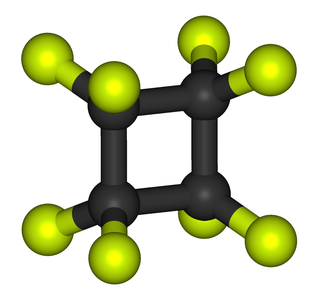Tetrafluoroethane is a fluoroalkane with two isomers:
- 1,1,2,2-Tetrafluoroethane (R-134)
- 1,1,1,2-Tetrafluoroethane (R-134a)
Tetrafluoroethane is a fluoroalkane with two isomers:
Freon is a registered trademark of the Chemours Company and generic descriptor for a number of halocarbon products. They are stable, nonflammable, low toxicity gases or liquids which have generally been used as refrigerants and as aerosol propellants. These include chlorofluorocarbons and hydrofluorocarbons, both of which cause ozone depletion and contribute to global warming. 'Freon' is the brand name for the refrigerants R-12, R-13B1, R-22, R-410A, R-502, and R-503 manufactured by The Chemours Company, and so is not used to label all refrigerants of this type. They emit a strong smell similar to acetone.

Aerosol spray is a type of dispensing system which creates an aerosol mist of liquid particles. It comprises a can or bottle that contains a payload, and a propellant under pressure. When the container's valve is opened, the payload is forced out of a small opening and emerges as an aerosol or mist.

A refrigerant is a working fluid used in the refrigeration cycle of air conditioning systems and heat pumps where in most cases they undergo a repeated phase transition from a liquid to a gas and back again. Refrigerants are heavily regulated due to their toxicity, flammability and the contribution of CFC and HCFC refrigerants to ozone depletion and that of HFC refrigerants to climate change.

Hydrofluorocarbons (HFCs) are man-made organic compounds that contain fluorine and hydrogen atoms, and are the most common type of organofluorine compounds. Most are gases at room temperature and pressure. They are frequently used in air conditioning and as refrigerants; R-134a (1,1,1,2-tetrafluoroethane) is one of the most commonly used HFC refrigerants. In order to aid the recovery of the stratospheric ozone layer, HFCs were adopted to replace the more potent chlorofluorocarbons (CFCs), which were phased out from use by the Montreal Protocol, and hydrochlorofluorocarbons (HCFCs) which are presently being phased out. HFCs replaced older chlorofluorocarbons such as R-12 and hydrochlorofluorocarbons such as R-21. HFCs are also used in insulating foams, aerosol propellants, as solvents and for fire protection.
Alternative music may refer to the following types of music:
Halocarbon compounds are chemicals in which one or more carbon atoms are linked by covalent bonds with one or more halogen atoms resulting in the formation of organofluorine compounds, organochlorine compounds, organobromine compounds, and organoiodine compounds. Chlorine halocarbons are the most common and are called organochlorides.
Dichlorodifluoromethane (R-12) is a colorless gas usually sold under the brand name Freon-12, and a chlorofluorocarbon halomethane (CFC) used as a refrigerant and aerosol spray propellant. In compliance with the Montreal Protocol, its manufacture was banned in developed countries in 1996, and in developing countries in 2010 out of concerns about its damaging effect on the ozone layer. Its only allowed usage is as a fire retardant in submarines and aircraft. It is soluble in many organic solvents. R-12 cylinders are colored white.
1,1,1,2-Tetrafluoroethane (also known as norflurane (INN), R-134a, Klea 134a,Freon 134a, Forane 134a, Genetron 134a, Green Gas, Florasol 134a, Suva 134a, HFA-134a, or HFC-134a) is a hydrofluorocarbon (HFC) and haloalkane refrigerant with thermodynamic properties similar to R-12 (dichlorodifluoromethane) but with insignificant ozone depletion potential and a lower 100-year global warming potential (1,430, compared to R-12's GWP of 10,900). It has the formula CF3CH2F and a boiling point of −26.3 °C (−15.34 °F) at atmospheric pressure. R-134a cylinders are colored light blue. A phaseout and transition to HFO-1234yf and other refrigerants, with GWPs similar to CO2, began in 2012 within the automotive market.

A gas duster, also known as tinned wind or compressed air, is a product used for cleaning or dusting electronic equipment and other sensitive devices that cannot be cleaned using water.
1-Chloro-1,2,2,2-tetrafluoroethane, C2HClF4, is a hydrochlorofluorocarbon used as a component in refrigerants offered as replacements for chlorofluorocarbons. HCFC-124 is also used in gaseous fire suppression systems as a replacement for bromochlorocarbons.
Fluoroform, or trifluoromethane, is the chemical compound with the formula CHF3. It is a hydrofluorocarbon as well as being apart of the haloforms, a class of compounds with the formula CHX3 with C3v symmetry. Fluoroform is used in diverse applications in organic synthesis. It is not an ozone depleter but is a greenhouse gas.

Octafluorocyclobutane, or perfluorocyclobutane, C4F8, is an organofluorine compound which enjoys several niche applications. Octafluorocyclobutane is a colourless gas and shipped as a liquefied gas. It is the perfluorinated analogue of cyclobutane whereby all C–H bonds are replaced with C–F bonds.

Iodotrifluoroethylene is the organofluorine compound with the formula C
2F
3I. It is a volatile colorless liquid.
Organofluorine chemistry describes the chemistry of organofluorine compounds, organic compounds that contain a carbon–fluorine bond. Organofluorine compounds find diverse applications ranging from oil and water repellents to pharmaceuticals, refrigerants, and reagents in catalysis. In addition to these applications, some organofluorine compounds are pollutants because of their contributions to ozone depletion, global warming, bioaccumulation, and toxicity. The area of organofluorine chemistry often requires special techniques associated with the handling of fluorinating agents.
CARE 30 is a refrigerant consisting of a blend of isobutane (R-600a) and propane (R-290) developed to replace dichlorodifluoromethane (R-12) and 1,1,1,2-tetrafluoroethane (R-134a). It is primarily for use in small commercial refrigeration and air-conditioning systems that have traditionally used R-12.
R-407A is a mixture of gasses used as a refrigerant. It is a zeotropic blend of difluoromethane (HFC-32), pentafluoroethane (HFC-125) and 1,1,1,2-tetrafluoroethane (HFC-134a). R-407A was developed as a close match to R-22's capacities and flow rates, making it well suited as an energy efficient retrofit for R-22 in medium and low temperature refrigeration systems for supermarket and food storage applications, but not for air conditioning systems or those with flooded evaporators. It must be used with synthetic oils. Its global warming potential is 2107.
R-407C is a mixture of hydrofluorocarbons used as a refrigerant. It is a zeotropic blend of difluoromethane (R-32), pentafluoroethane (R-125), and 1,1,1,2-tetrafluoroethane (R-134a). Difluoromethane serves to provide the heat capacity, pentafluoroethane decreases flammability, tetrafluoroethane reduces pressure. R-407C cylinders are colored burnt orange.

Clean agent FS 49 C2 is an environmentally engineered, human safe, fast acting Clean Agent fire extinguishing gas for gaseous fire suppression installed in a suited fire suppression system. The gas consists of tetrafluoroethane, pentafluoroethane and carbon dioxide.

Teflurane is a halocarbon drug which was investigated as an inhalational anesthetic but was never marketed. Its clinical development was terminated due to a high incidence of cardiac arrhythmias in patients, similarly to the cases of halopropane and norflurane.

Freeze spray is a type of aerosol spray product containing a liquified gas used for rapidly cooling surfaces, in medical and industrial applications. It is usually sold in hand-held spray cans. It may consist of various substances, which produce different temperatures, depending on the application.